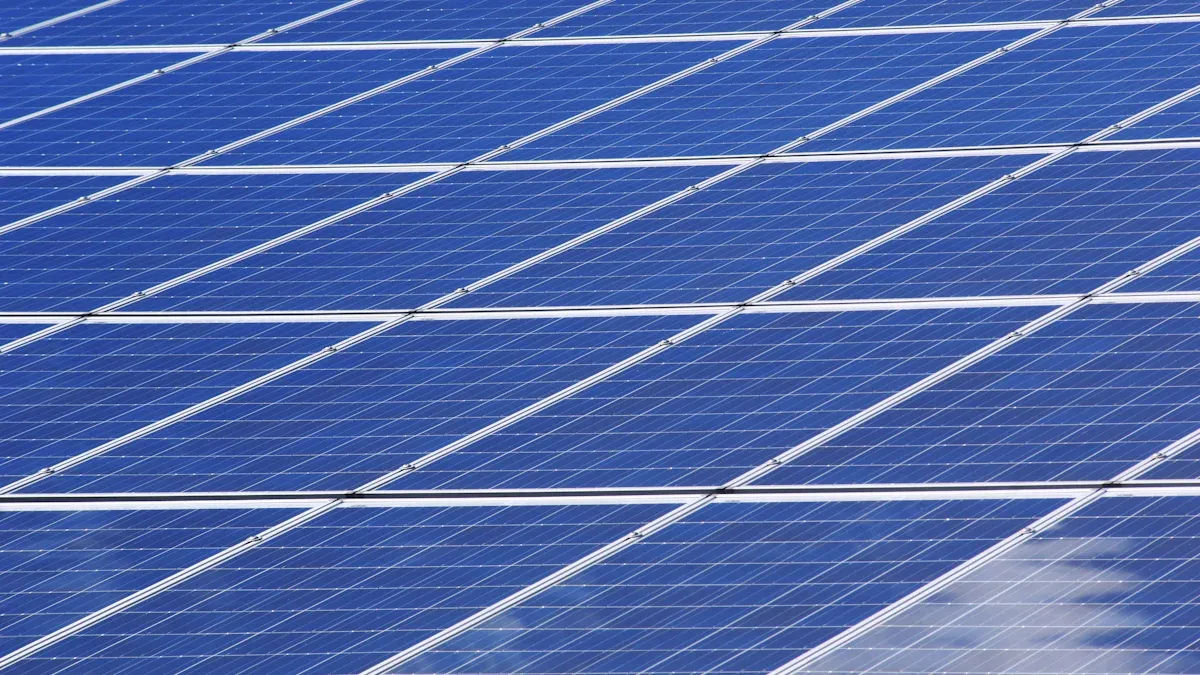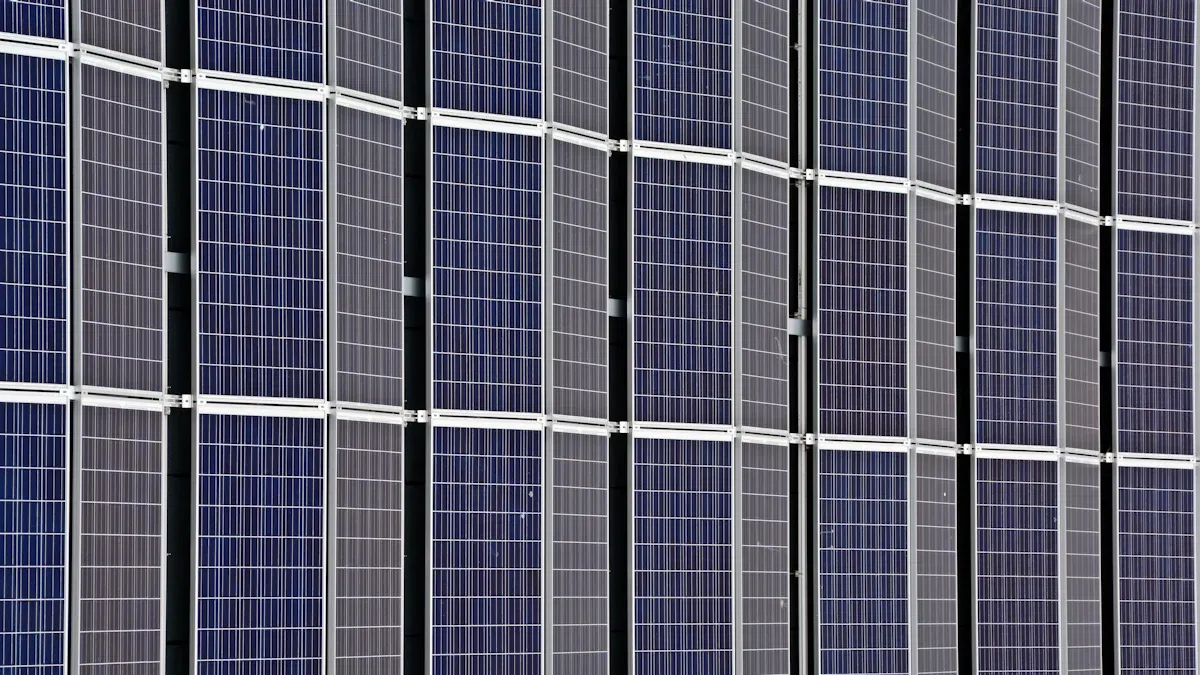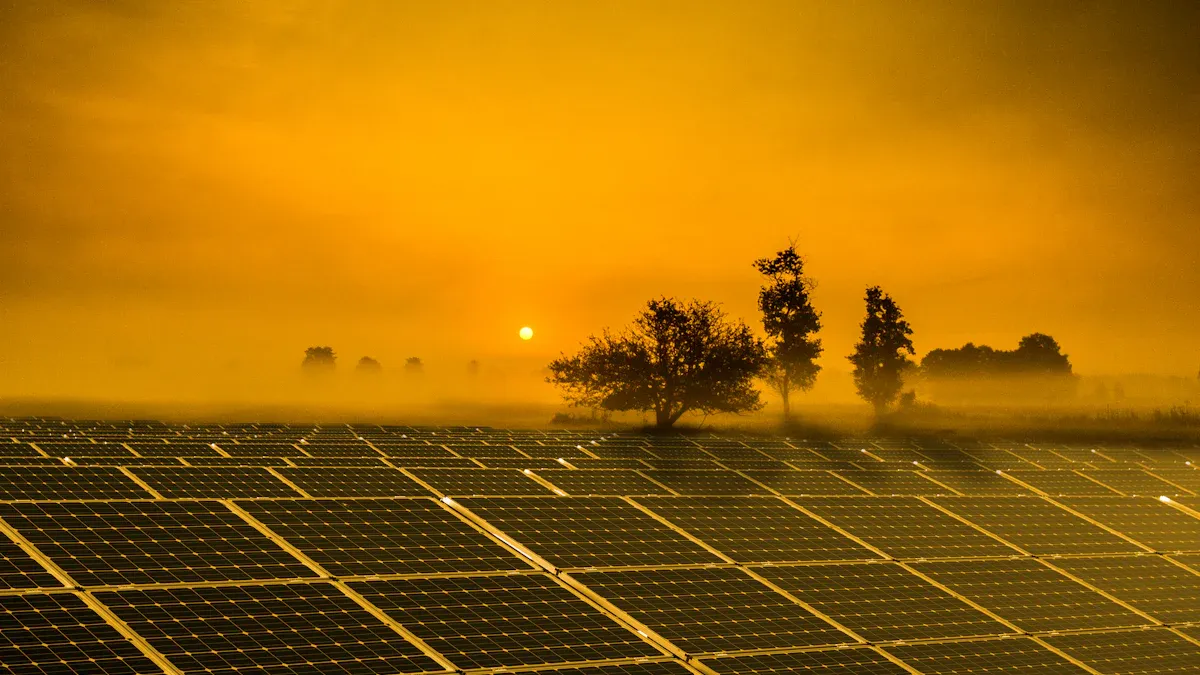Which ESTEL PV Panel Is Best for Telecom Cabinets

The ESTEL UltraMax Pro 410W emerges as the leading pv panel for telecom cabinet applications in 2025. Its high efficiency and robust durability set it apart for telecommunication and data center environments. Operators demand energy reliability and low electricity consumption. The UltraMax Pro 410W’s advanced pv cell design delivers over 98% conversion efficiency, ensuring stable energy output even in challenging climates.
Telecom and data center managers see significant value in the UltraMax Pro’s extended 25-year warranty and its proven ability to reduce energy consumption and CO2 emissions.
Metric | Data |
|---|---|
$0.20–$0.30 per Watt | |
Solar electricity cost reduction | Over 80% since 2010 |
Battery cost reduction | Over 90% since 2010 |
Projected panel efficiency (2030) | Exceeds 30% |
CO2 reduction (hybrid pv systems) | 55% |
CO2 reduction (with 5G adoption) | 58% |
This data-driven approach confirms why the UltraMax Pro 410W stands as the optimal pv panel for telecom cabinet and data center energy needs in 2025.
Key Takeaways
The ESTEL UltraMax Pro 410W offers top energy efficiency and reliable power, making it ideal for telecom cabinets and data centers.
Its durable design withstands harsh weather like high winds, snow, and heat, ensuring stable electricity even in tough conditions.
Using ESTEL panels helps reduce electricity costs and CO2 emissions, supporting sustainable and carbon-free energy goals.
Steel support structures from ESTEL provide long-lasting strength and lower maintenance, saving money over time.
Regular cleaning and inspections keep the panels working well, with simple maintenance routines that minimize downtime.
Comparison of ESTEL PV Panels

Key Features
ESTEL offers a range of pv panels for telecom cabinet and data center applications. The company focuses on delivering high efficiency, reliable energy output, and robust durability. The following table compares the main types of ESTEL solar panels used in telecommunication and data center environments:
Feature | Monocrystalline Panels | Polycrystalline Panels | Thin-film Panels |
|---|---|---|---|
Efficiency Range | 15% - 17% (Mid-tier efficiency) | 10% - 13% (Lowest efficiency) | |
Power Output | Higher power output due to better efficiency and material quality | Moderate power output | Lower power output due to less efficient materials |
Durability | Strong weather, impact, and temperature resistance; typically backed by 10-15 year product warranty and 25-year performance warranty (≥80% efficiency retention) | Good durability but slightly less robust than monocrystalline; similar warranty terms | Generally less durable; more sensitive to environmental factors; warranties may vary |
Durability Features | Weather resistance, impact resistance (e.g., hail up to 1 inch at 50 mph), temperature tolerance | Similar features but may have slightly lower impact resistance | More flexible but less resistant to harsh conditions |
Warranty | Product warranty: 10-15 years; Performance warranty: ≥80% efficiency after 25 years | Similar warranty coverage | Varies, often less comprehensive |
ESTEL integrates advanced solar technologies into its pv panels. Multi-layered cells and anti-reflective coatings improve efficiency, especially in low-light conditions. The panels use tempered glass and corrosion-resistant frames, which help them withstand harsh weather. Each solar pv array meets international standards for durability and performance. The company also emphasizes sustainability in its renewable energy production process, reducing waste and environmental impact.
Suitability for Telecom Cabinets
ESTEL pv panels support the unique needs of telecommunication and data center operators. The panels maintain stable electricity output year-round, adapting to seasonal and weather changes. High-temperature tolerance and effective low-light energy capture ensure reliable energy supply for critical telecom equipment. The panels’ robust construction protects against heavy snow, high winds, and hail, which is essential for outdoor telecom cabinet installations.
ESTEL’s commitment to renewable energy and future-proofing allows operators to scale their solar systems as electricity demand grows. The company’s warranties protect investments in renewable solutions for the long term.
In 2025, ESTEL aligns with leading solar trends such as bifacial cell technology, high wattage output, and improved renewable energy capture. These features make ESTEL panels a top choice for telecom cabinet and data center applications, where continuous electricity and energy efficiency are vital.
Best PV Panel for Telecom Cabinet
Efficiency and Power Output
The ESTEL UltraMax Pro 410W stands out as the most effective pv panel for telecom cabinet applications in 2025. This model delivers exceptional efficiency, meeting the high power demand of modern telecommunication and data center operations. The panel’s advanced pv cell design ensures that solar energy conversion remains above 98%, even during periods of fluctuating sunlight or partial shading. Operators in the data center sector rely on consistent electricity to maintain uptime and prevent service interruptions. The UltraMax Pro 410W addresses these needs by providing stable solar energy output, which supports critical power supply requirements.
Data center facilities often experience variable power demand due to fluctuating workloads. The UltraMax Pro 410W adapts to these changes by maximizing solar energy capture throughout the day. Telecommunication infrastructure, especially in remote locations, benefits from the panel’s ability to deliver reliable electricity without frequent manual intervention. This high level of efficiency reduces the need for backup generators and lowers overall energy costs for operators.
Durability and Reliability
Durability remains a top priority for any pv panel for telecom cabinet use. The UltraMax Pro 410W incorporates robust materials and advanced engineering to withstand harsh environmental conditions. Data center and telecommunication sites often face extreme weather, including high winds, heavy snow, and rapid temperature changes. The panel’s construction uses tempered glass and corrosion-resistant steel frames, which protect the pv cells from physical damage and environmental degradation.
Amorphous silicon (a-Si) cells in the UltraMax Pro 410W offer several advantages:
Flexible characteristics help the panel endure thermal stresses.
A low negative power-temperature coefficient (~−0.1%/°C) ensures minimal performance loss as temperatures rise.
The panel operates effectively at elevated temperatures between 60–80 °C, reducing defect states caused by thermal stress.
Long-term operation at high temperatures does not compromise reliability.
These features enable the panel to maintain stable electricity output under extreme weather and temperature fluctuations.
Data center operators value this reliability, as uninterrupted electricity is essential for maintaining network integrity. Telecommunication providers also benefit from the panel’s resistance to damage, which reduces downtime and maintenance costs. The UltraMax Pro 410W’s 25-year performance warranty further assures operators of sustained energy production and long-term value.
Installation and Maintenance
Professional installation is standard for ESTEL pv panels, especially in data center and telecommunication environments where system reliability is critical. The UltraMax Pro 410W requires skilled technicians for setup, which increases initial installation costs. However, this approach ensures optimal system performance and activates comprehensive warranties covering both installation and ongoing system efficiency.
Maintenance routines for the UltraMax Pro 410W are straightforward. Operators schedule cleaning every three to six months or after major storms. In dusty or industrial areas, professional cleaning helps maintain solar panel efficiency and prevents degradation. Data center and telecommunication sites benefit from this low-maintenance approach, as it minimizes operational disruptions and reduces long-term energy costs.
The following table compares installation and maintenance costs for different support materials used in pv panel systems:
Material | Installation Cost Impact | Maintenance Cost & Durability | Notes on Suitability for Telecom Cabinets |
|---|---|---|---|
Steel (ESTEL) | Higher initial installation cost due to professional installation and durable materials | Lower maintenance costs over time due to robustness, anti-corrosion treatments, and warranties | Offers superior strength and long-term reliability, ideal for harsh environments and telecom cabinets requiring durability |
Aluminum | Lower installation labor costs due to lightweight nature | May require more frequent maintenance in harsh environments; good corrosion resistance in dry areas | Lightweight, easier to install but less strong than steel; may reduce upfront costs but potentially higher maintenance |
Stainless Steel | Higher cost than steel, increasing installation expenses | Excellent corrosion resistance, reducing maintenance frequency but at a premium cost | Best for coastal or high-humidity areas; cost may not justify use in all telecom cabinet installations |
Wood | Lower upfront installation cost | Higher maintenance costs due to susceptibility to warping, decay, and environmental damage | Less durable, not recommended for long-term telecom cabinet PV support due to environmental vulnerability |
ESTEL’s steel structures, used for supporting the UltraMax Pro 410W, are engineered for durability in extreme weather. Operators conduct biannual inspections to check for corrosion, loose fasteners, and coating wear. In harsh environments, more frequent inspections may be necessary. Advanced anti-corrosion treatments on steel components reduce the need for frequent maintenance, resulting in lower long-term costs compared to alternative materials.
Data center and telecommunication managers appreciate the balance between higher initial installation costs and reduced long-term maintenance expenses. This approach ensures reliable solar energy delivery and consistent electricity for critical infrastructure.
Alternative ESTEL Solar Options
Runner-Up Models
ESTEL offers several alternative solar panels that serve data center and telecom cabinet needs. The UltraMax Eco 380W and the PowerCell 400W models both deliver strong energy performance. Many data center operators choose these panels for projects where energy demand is moderate or where initial cost is a primary concern. The UltraMax Eco 380W uses high-efficiency monocrystalline cells. It provides reliable energy output for data center environments that require stable electricity but have limited space. The PowerCell 400W panel features bifacial technology. This design allows the panel to capture energy from both sides, increasing total energy yield for data center rooftops and ground-mounted systems.
Data center managers often select these runner-up models when balancing energy requirements and cost constraints. These panels help reduce energy expenses while supporting the operational needs of a modern data center.
Pros and Cons
The following table summarizes the main advantages and disadvantages of the UltraMax Eco 380W and PowerCell 400W for data center applications:
Model | Pros | Cons |
|---|---|---|
UltraMax Eco 380W | Lower cost, good energy efficiency, compact size for data center use | Slightly lower energy output than flagship models |
PowerCell 400W | Bifacial energy capture, high durability, strong data center fit | Higher initial cost, requires optimal placement for max energy |
UltraMax Eco 380W reduces upfront cost for data center projects. It delivers consistent energy, making it suitable for smaller data center installations.
PowerCell 400W maximizes energy production in data center environments with reflective surfaces. The higher cost may impact budget planning, but the increased energy yield can offset this over time.
Choosing the right panel depends on the specific energy needs, available space, and cost targets of each data center project.
Selection Criteria for Telecom and Data Center Use
Performance Needs
Data center and telecommunication operators require pv panels that deliver consistent electricity output. High electricity consumption and variable power demand drive the need for reliable solar energy. The UltraMax Pro 410W panel supports these requirements by maintaining stable energy production, even during peak electricity demand. Operators see improved data center efficiency and reduced electricity consumption. The panel’s advanced pv technology ensures that renewable energy supports both on-grid and off-grid outdoor telecommunication site operations. This approach helps organizations meet carbon-free energy targets and supports the transition to sustainable solutions.
Environmental Resistance
Telecommunication sites and data center facilities often face harsh weather and environmental challenges. The UltraMax Pro 410W panel uses corrosion-resistant materials, including marine-grade steel and specialized epoxy coatings. These features protect against moisture, salt, and dust accumulation. Advanced weatherproof coatings provide anti-soiling and self-cleaning properties, which reduce dust buildup and lower maintenance needs. The steel structures withstand temperature extremes, UV radiation, and severe weather such as hurricanes and snow. Regular maintenance, including inspection and reapplication of coatings, helps sustain resistance to corrosion and environmental damage over time. This robust design ensures reliable electricity supply and supports the energy transition to carbon-free operations.
System Compatibility
Modern data center and telecommunication systems require pv panels that integrate seamlessly with existing infrastructure. The UltraMax Pro 410W panel offers broad compatibility with renewable energy storage, hybrid solar systems, and advanced monitoring solutions. Operators can scale their solar installations as electricity consumption grows. The panel’s design supports both grid-tied and off-grid applications, making it ideal for remote telecommunication sites. This flexibility allows organizations to adopt energy-efficient solutions and maximize the benefits of renewable energy.
Cost Considerations
Cost remains a critical factor for data center and telecommunication operators. The UltraMax Pro 410W panel balances higher initial installation cost with long-term savings. Durable materials and advanced coatings reduce maintenance expenses and extend the panel’s lifespan. Operators benefit from lower electricity consumption, reduced reliance on fossil fuels, and decreased operational costs. The transition to carbon-free energy and renewable solutions supports sustainability goals and delivers a strong return on investment. Organizations achieve sustainable, cost-effective energy solutions that meet the growing electricity demand of modern data center and telecommunication operations.
Real-World Results

User Feedback
Operators in the data center industry report strong satisfaction with ESTEL pv panels. Many highlight the UltraMax Pro 410W for its ability to reduce electricity consumption and support carbon-free operations. One manager noted a significant drop in electricity costs after switching to ESTEL pv solutions. The panel’s stable energy output meets the high electricity demand of modern data center environments. Users also value the reduction in downtime, which supports continuous electricity supply for critical infrastructure.
GreenConnect, a major telecom provider, deployed ESTEL’s standalone pv solutions across 500 remote telecommunication sites. The company observed a 30% decrease in energy consumption and a 40% reduction in CO2 emissions. Downtime dropped by 25%, which improved reliability and reduced operational costs. The easy installation and maintenance of these pv panels allowed GreenConnect to meet sustainability goals and accelerate the transition to carbon-free energy. Operators found the panels effective in harsh environments, supporting the energy transition for telecommunication sites.
Field tests confirm that ESTEL’s AI-driven monitoring accurately predicts battery performance. This technology helps operators schedule maintenance before failures occur. As a result, data center managers experience fewer interruptions and maintain stable electricity consumption. The advanced monitoring system ensures reliable energy delivery and supports sustainable operations.
Case Studies
Researchers have studied the effectiveness of pv panels in data center and telecom deployments. The following table summarizes key findings:
Study | Key Findings | Location | Optimal Tilt Angle |
|---|---|---|---|
Hussein et al. | South-facing PV panels with tilt angles between 20° and 30° yield highest power output. | N/A | 20°-30° |
Jamil et al. | Annual optimum tilt angles around 27.6° to 27.95° for locations in India. | Aligarh, Delhi, India | 27.62°, 27.95° |
Bahanni et al. | Polycrystalline solar cells outperform other technologies regardless of location. | Morocco | N/A |
These studies show that proper tilt angles and panel selection maximize electricity output and reduce electricity consumption. Polycrystalline pv panels, such as those from ESTEL, deliver superior energy performance in diverse climates. Data center operators use these findings to optimize pv installations and support sustainable, carbon-free energy solutions. The research supports the ongoing transition to carbon-free operations and highlights the importance of advanced pv technology in meeting electricity demand and reducing overall consumption.
The ESTEL UltraMax Pro 410W stands as the top pv solution for telecom cabinets and data center operations. Operators see significant reductions in electricity consumption and improved energy reliability. ESTEL steel structures deliver unmatched durability, corrosion resistance, and adaptability, supporting various solar panel types and advanced tracking systems. These features lower electricity costs, minimize maintenance, and extend service life. Data center managers benefit from stable energy output, reduced consumption, and simplified installation. For tailored pv solutions that optimize electricity consumption and energy efficiency, organizations should consult ESTEL’s experts.
FAQ
What makes the ESTEL UltraMax Pro 410W ideal for telecom cabinets?
The UltraMax Pro 410W delivers high energy efficiency and reliable output. Its robust design withstands harsh environments. Telecom operators trust this panel for stable energy supply and reduced maintenance needs.
How does ESTEL ensure long-term energy performance?
ESTEL uses advanced materials and engineering. The panels maintain consistent energy output over decades. Regular inspections and protective coatings help preserve energy efficiency and extend service life.
Can ESTEL PV panels operate in extreme weather?
Yes. ESTEL PV panels resist high winds, snow, and temperature swings. The panels maintain energy production during storms and heatwaves. Operators report minimal downtime in challenging climates.
Are ESTEL panels compatible with existing energy systems?
ESTEL panels integrate with most telecom and data center energy systems. They support both grid-tied and off-grid setups. This compatibility allows operators to scale energy solutions as demand grows.
What maintenance do ESTEL PV panels require?
Operators clean the panels every few months to maintain energy efficiency. Inspections check for corrosion or damage. Most users find the maintenance routine simple and cost-effective.
See Also
Solar Powered Energy Storage Solutions For Telecom Cabinets
An Overview Of ESTEL Telecom Cabinet Power Systems
A Detailed Look At ESTEL Outdoor Telecom Cabinet Design
Safety Features In Custom ESTEL Outdoor Telecom Cabinets
Battery Solutions For Energy Storage In ESTEL Telecom Cabinets
CALL US DIRECTLY
86-13752765943
3A-8, SHUIWAN 1979 SQUARE (PHASE II), NO.111, TAIZI ROAD,SHUIWAN COMMUNITY, ZHAOSHANG STREET, NANSHAN DISTRICT, SHENZHEN, GUANGDONG, CHINA


